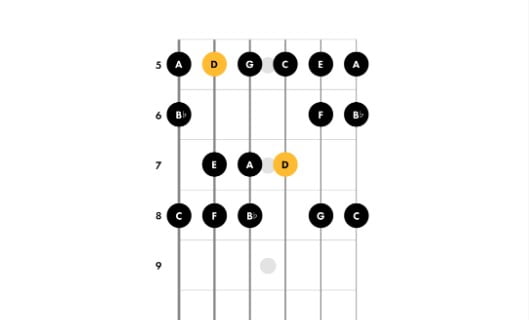How to play the D minor scale on Guitar
The D minor scale is a versatile musical progression that can add emotional contrast to major scales. It is composed of three patterns - natural, harmonic, and melodic - and is frequently used in popular songs such as "Crazy in Love" by Beyonce, "Set Fire to the Rain" by Adele, and. Historically, classical composers have regarded the D minor scale as the most melancholy series of notes, making it ideal for conveying sadness and grief in a song. This lesson will cover the notes and finger placements necessary to play the D minor scale on your guitar in various positions. It is an essential scale for new guitarists to learn due to its emotional range and versatility.
Notes in the D minor scale
The D minor scale consists of seven notes:
- D
- E
- F
- G
- A
- Bb
- C
Interestingly, the F major scale shares the same notes as the D minor scale, but in a different order. This similarity makes F major the relative major of D minor. If you want to play the this scale on your guitar, you need to learn various finger placements and positions. In the following section, we will cover some of these essential finger placements and positions.
D minor scale position
To learn the D minor scale, you can use guitar scale diagrams that visually represent the fretboard of your guitar. Each dot on the diagram indicates a specific note that you need to play on a particular fret and string. If a dot has a note written above the string, you need to play that string in an open position. The yellow dots on the diagram represent the root note of the scale, which is D in this case. Since minor scales are composed of three patterns - natural, harmonic, and melodic - we will focus only on the D minor natural scale to simplify this lesson.
Open position
To play the D minor scale in the open position, start by using your index finger to play notes on the first fret, your middle finger for notes on the second fret, and your ring finger for notes on the third fret. This finger placement will help you play the scale properly.

5th position
To play the D minor scale in fifth position, place your index finger on the fifth fret, your middle finger on the sixth fret, your ring finger on the seventh fret, and your pinky on the eighth fret. This finger placement will help you to play the scale correctly.

D minor scale tabs
Guitar scale diagrams are an excellent tool for learning scales, but they are not the only option. Guitar tablature, or "tabs," provides an alternative method for learning how to play the same scales. Tabs can help guitarists visualize playing the scale differently, and some find them easier to learn than diagrams. However, it's worth noting that there is no one right way to learn scales; it depends on what works best for you. By understanding both charts and tabs, you can expand your knowledge of the guitar and different approaches to playing. In the next section, we will cover the guitar tabs for each of the scales we just studied.
Open position tab
To play the D minor scale in the open position, begin by playing the open D string, followed by placing your middle finger on the second fret of the same string. Follow the tab provided below to continue playing the scale.

5th position tab
To play the D minor scale in fifth position, place your index finger on the fifth fret of the fifth string (A) and follow the tab below to continue playing the scale.

D minor scale exercises
One effective way to memorize scales is to play them repeatedly, starting slowly and ensuring that you're fretting each note cleanly and using the correct finger placement. As you become more familiar with the scales and develop greater finger strength and dexterity, you can gradually increase your playing speed. To help keep time while practicing, consider using a metronome.
You may also want to try playing various positions of the D minor scale in sequence, starting in the open position and transitioning to the fifth or other positions you wish to learn. As you play, listen for differences in pitch resulting from playing the same notes in different positions on the fretboard.
Practicing scales is also an excellent opportunity to perfect your picking technique. Use your scale practice to work on alternate picking. Once you've mastered the D minor scale, you'll be ready to tackle new scales, songs, and chords. You can learn more about these topics and more lessons on Guitar tunio.







